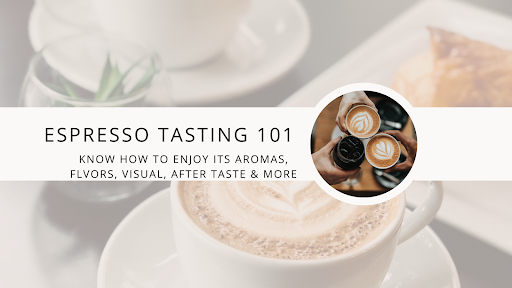Since you are here, you probably already know what espresso is and what it tastes like. A drink with roots as old as the 19th century, it is enjoyed by millions of people around. However, most are oblivious of its luxurious creamy texture and the lingering aftertaste. It is a concentrated, complex, and bold drink with a century-long heritage.
When tasting an espresso, experts usually define it in terms of complexity, sweetness, and acidity. However, for a layman, it can be daunting to understand these elements in one go. Nonetheless, the first step in your journey to becoming an expert could be to start tasting espresso instead of gulping it down right away.
THINGS TO NOTICE WHEN DRINKING AN ESPRESSO
When you truly taste an espresso, you notice the various elements like aroma, taste, aftertaste, texture, etc., that together make a coffee good or bad, and create an unmatched experience. Below are the elements you must consider:
Visual: A sight to behold as it settles into a cup, espresso looks like a cup of luxury as it settles—however, very few baristas specialize in putting espresso straight into the cup making the visual a rare occurrence. The crema must be mahogany-dark in colors (like a dark oak) and marked with tiny bubbles from the gases released during the brew cycle. The occurrence of light-colored spots is not a good sign as it indicates that the pull went too long. It should have enough viscosity to support added sugar.
That said, a cup of thick, amazing crema can taste disgusting due to the lack of or witness in crema.
Aroma: The second thing you’d notice in espresso as you bring the cup closer to your face is the aroma. It is one of the key indicators of the taste of coffee—this tells in volume about whether the coffee is good or bad. Sensing the aromas of a coffee is just like that of wine; exhale fully and then bring your nose close to your espresso. Now take a long, deep inhale so that you are able to discern all the elements. Cupping your hands over the brew can deviate all the aromas to your nose and also leave some fragrances on your hands; pretty much on anything, it is in contact with. You can repeat as many times to get a sense of what your drink will be like in the mouth. A bad coffee may taste burnt, and you can tell that just by a whiff.
Ideally, the aromas of a perfect cup of espresso must be rich, complex & deep. You might experience changes in the fragrances as you whiff multiple times, although certain aromas that should definitely not be in your coffee are chemical odor, burnt and foul. If your brew emanates burnt rubber then that is a signal for you to put that cup down and walk away.
Tasting: Tasting an espresso is very different from drinking a cup of coffee. The sense of smell and taste are very closely associated—so, when you inhale the aroma of your coffee, exhale a bit and take a gentle, small sip from the cup. This way, the espresso flows from the back to the front of your tongue, then swish it around in your mouth a bit to cover as much as possible before swallowing. It is important to exhale before you inhale the aroma; this creates room in your lung to absorb the aromas of the coffee and allows the volatile elements to go deep, revealing all that might be.
While espresso is a strong and concentrated drink, it boats of more flavors than any other coffee preparation method. Many of these elements are extremely subtle and need sensitive handling in the mouth to understand & relish them to the fullest. Also, some elements in espresso mask the bitterness of caffeine; therefore, the first sip may not be able to reveal all that your coffee has—sip, pause and sip again, a few times to truly relish all the flavors it has to offer. However, if even after a couple of sips, all you can taste are unpleasant bitter, acidic, burnt, thin, and bad flavors, then you do not have to torture yourself and can simply pour that brew into the drain 😛 as no matter how many times you try, those bad flavors are not going anywhere.
Feel: A rich brew, it should feel like melted butter in your mouth with a thick, smooth, heavy, greasy, and oily texture (and all in a positive manner). There should be a sensible viscosity, flow, and weight, different from water. While water is always in a hurry to rush to the stomach, an espresso should feel like it wants to stay in your mouth as you enjoy its every sip.
After Taste: If you are having good espresso, then it might not go anywhere for a substantial period of time. Avoid swallowing the coffee; you should be able to expectorate every spittle that builds up in your mouth. A really good espresso is highly likely to stay for at least 10-20 mins in your mouth after it has gone down your throat. If you are having a burning sensation or a bad aftertaste from poor espresso quality, it is better to get rid of these with some water.
We’re sure that this read will change how you drink coffee, and the next time you’ll have your brew, the experience is going to be much better as you’ll be able to enjoy and appreciate all these elements to the fullest. Hope you liked this article. Stay tuned as we bring to you more insightful reads in the following weeks.



